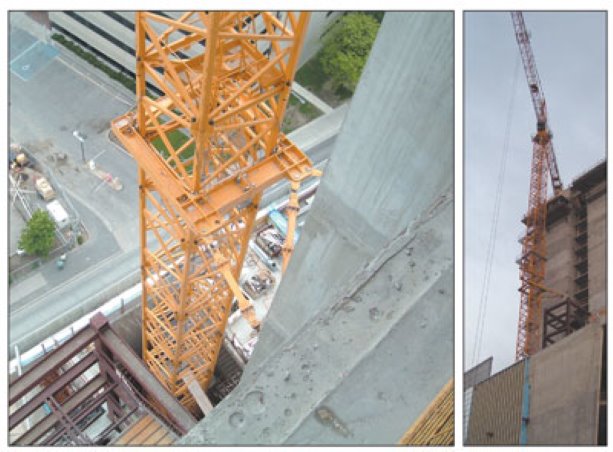In Ontario, construction cranes are traditionally controlled by forming contractors who operate them on behalf of the general contractor and allocate crane time to sub-trades. But that model is slowly changing, in part reflecting the U.S. model where general contractors are responsible for cranes and concrete is more often pumped, not poured from a bucket.
Site Operations
In Ontario, construction cranes are traditionally controlled by forming contractors who operate them on behalf of the general contractor and allocate crane time to sub-trades. But that model is slowly changing, in part reflecting the U.S. model where general contractors are responsible for cranes and concrete is more often pumped, not poured from a bucket.
“In Ontario, there are now more concrete pumps available, and concrete can be placed faster,” says Paul Sandberg, sales manager for Morrow Tower Cranes and Hoists in Mississauga. “We expect that this development will slowly continue, and forming contractors will invest more capital in pumps and less in cranes. With fewer cranes being owned by forming contractors, the responsibility for cranes will shift from the forming contractors to the general contractors.”
Eastern Construction took that route on the recent Windsor Casino project.
“The casino was a fast-track project with the completion date set in stone,” says Renato Tacconelli, vicepresident of Operations at Eastern.
“We had to plan what we were doing with the crane before we brought in a forming contractor, so we purchased the crane ourselves.”
But when general contractors take responsibility for cranes, they may be inclined to bypass traditional bottom climbing cranes set on the building itself — which favour forming contractors — for top-climbers, which are erected beside the building and hydraulically extended as new sections of the crane tower are inserted.
Eastern specified a top-climber in both the casino project and the construction of the Portofino Condominium project, also in Windsor. “We didn’t want to get a bottom climber which leaves behind a cavity or hole,” says Tacconelli. “If you’re a general, you can specify a top-climber and keep it outside the building where it can service most of the trades and the interference with construction is minimal.”
Denis Furlan, Director of Alliance Forming in Toronto says that more projects are being designed to use top-climbers.
“Some of the generals are forcing the issue in the tender package,” he says. “They say they want to eliminate the problem with finishing the interiors of the buildings one unit below the crane. But if you put a top climber on the side of a building, it might require a boom of 70 or 80 metres to reach all areas of the project. In the middle of the building, you only need a boom of 25 to 35 metres. The shorter the boom, the faster the crane moves and the more weight it can lift each time.”
Ontario faces no current shortage of cranes, but is experiencing a shortage of crane operators, most of whom are employed by forming contractors.
“We tend to like to have control of the cranes,” says Furlan. “We employ the operators and it’s a better fit within the critical path of construction.”
But as older crane units in Ontario are retired, Sandberg predicts a continuing trend toward investment in top-climbing cranes by general contractors. “The forming contractors will be choosing between investing in concrete pumps and replacing older booms or cranes,” he says.
“Since they will not be depending on the typical bottom-climbing cranes available from the forming contractors, you will see general contractors taking responsibility for cranes and investing in top-climbers.”











Recent Comments
comments for this post are closed